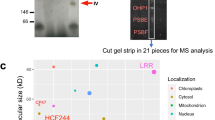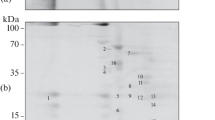Abstract
The precursor to the nuclear-coded 17 kDa early light-inducible protein (ELIP) of pea has been transported into isolated intact chloroplasts. The location of the mature protein in the thylakoid membranes was investigated after using cleavable crosslinkers such as DSP and SAND in conjunction with immuno-fractionation methods and by application of mild detergent fractionation. We show that ELIP is integrated into the membranes via the unstacked stroma thylakoids. After isolation of protein complexes by solubilization of membranes with Triton X-100 and sucrose density-gradient centrifugation the crosslinked ELIP comigrates with the PS II core complex. Using SAND we identified ELIP as a 41–51 kDa crosslinked product while with DSP four products of 80 kDa, 70 kDa, 50–42 kDa and 23–21 kDa were found. The immunoprecipitation data suggested that the D1-protein of the PS II complex is one of the ELIP partners in crosslinked products.
Similar content being viewed by others
Abbreviations
- chl:
-
chlorophyll
- D1 :
-
herbicide-binding protein
- DSP:
-
dithiobis-(succinimidylpropionate)
- ELIP:
-
early light-inducible protein
- LHC I and LHC II:
-
light-harvesting chlorophyll a/b complex associated with photosystem I or II
- PAGE:
-
polyacrylamide gel electrophoresis
- poly(A)-rich RNA:
-
polyadenyd mRNA
- PS I and PS II:
-
photosystems I and II
- SAND:
-
sulfosuccinimidyl 2-(m-azido-o-nitro-benzamido)-ethyl-1,3′-dithiopropionate
- Triton X-100:
-
octylphenoxypolyethoxyethanol
References
Akoyunoglou A, Akoyunoglou G: Mechanism of thylakoid reorganization during chloroplast development in higher plants. Israel J Bot 33: 149–162 (1984).
Akoyunoglou G, Argyroudi-Akoyunoglou JH: Organization of the photosynthetic units, and onset of electron transport and excitation energy distribution in greening leaves. Photosynth Res 10: 171–180 (1986).
Akoyunoglou G, Argyroudi-Akoyunoglou JH: Posttranslational regulation of chloroplast differentiation. In: Akoyunoglou G, Senger H (eds) Regulation of Chloroplast Differentiation, pp. 571–582. Alan R. Liss, New York (1986).
Apel K, Kloppstech K: The plastid membranes of barley (Hordeum vulgare). Light-induced appearance of mRNA coding for the apoprotein of the light-harvesting chlorophyll a/b protein. Eur J Biochem 85: 581–588 (1978).
Bogorad L: Chloroplasts. J Cell Biol 91: 256–270 (1981).
Bonner WM, Laskey RA: A film detection method for tritium-labelled proteins and nucleic acids in polyacrylamide gels. Eur J Biochem 46: 83–88 (1974).
Cullen SE, Schwartz BD: An improved method for isolation of H-2 and IA alloantigens with immunoprecipitation induced by protein A bearing Staphylococci. J Immunol 117: 136–142 (1976).
Cuming AC, Bennett J: Biosynthesis of the lightharvesting chlorophyll a/b protein. Control of messenger RNA activity by light. Eur J Biochem 118: 71–80 (1981).
DeBlas AL, Czerwinski HM: Detection of antigens on nitrocellulose paper immunoblots with monoclonal antibodies. Anal Biochem 133: 214–219 (1983).
Douce R, Joyard J: Structure and function of the plastid envelope. Adv Bot Res 7: 1–116 (1979).
Enami I, Satoh K, Katoh S: Crosslinking between the 33 kDa extrinsic protein and the 47 kDa chlorophyll carrying protein of the PS II reaction center core complex. FEBS Lett 226: 161–165 (1987).
Fluhr R, Kuhlemeier C, Nagy F, Chua NH: Organ-specific and light induced expression of plant genes. Science 232: 1106–1112 (1986).
Fromm H, Devic M, Fluhr R, Edelman M: Control of psbA gene expression in mature Spirodela chloroplasts: Light regulation of 32-kd protein synthesis is independent of transcript level. EMBO J 4: 291–295 (1985).
Gallagher TF, Ellis RJ: Light-stimulated transciption of genes for two chloroplast polypeptides in isolated pea leaf nuclei. EMBO J 1: 1493–1498 (1982).
Grimm B, Kloppstech K: The early light inducible proteins of barley. Characterization of two families of 2-h-specific nuclear-coded chloroplast proteins. Eur J Biochem 167: 493–499 (1987).
Grimm B, Kruse E, Kloppstech K: Transiently expressed early light-inducible thylakoid proteins share transmembrane domains with light-harvesting chlorophyll binding proteins. Plant Mol Biol 13: 583–593 (1989).
Grossman AR, Bartlett SG, Schmidt GW, Mullet JE, Chua NH: Optimal conditions for post-translational uptake of proteins by isolated chloroplasts. J Biol Chem 257: 1558–1563 (1982).
Holger JH, Kaplan S: Topology and neighbour analysis of the photosynthetic reaction centre from Rhodopseudomonas sphaeroides. J Biol Chem 260: 6932–6937 (1985).
Ji TH: The application of chemical crosslinking for studies on cell membranes and the identification of surface reporters. Biochim Biophys Acta 559: 39–69 (1979).
Kloppstech K: Diurnal and circadian rhythmicity in the expression of light-induced plant nuclear messenger RNAs. Planta 165: 502–506 (1985).
Kloppstech K, Meyer G, Bartsch K, Hundrieser J, Link G: Control of gene expression during the early phase of chloroplast development. In: Wiesner W, Robinson DG, Starr RC (eds) Compartments in algal cells and their interaction, pp. 36–46. Springer-Verlag, Berlin/Heidelberg/New York (1984).
Kloppstech K, Pfisterer J, Meyer G, Müller M: Control of expression of chloroplast membrane proteins in higher plants. In: Cell Function and Differentiation Part B: 101–110, Alan R. Liss, New York (1982).
Knack G, Otto B, Ottersbach P, Alexander R, Liu Z, Kloppstech K: Structure and possible function of chloroplast heat-shock proteins and effect of cyclic heat-shock on plastid morphogenesis and circadian rhythmicity. In: Baltscheffsky M (ed) Current Research in Photosynthesis, vol 6: 579–586. Martinus Nijhoff Publishers, The Netherlands (1990).
Kohorn BD, Harel E, Chitnis PR, Thornber JP, Tobin EM: Functional and mutational analysis of the light-harvesting chlorophyl a/b protein of thylakoid membranes. J Cell Biol 102: 972–981 (1986).
Lewis RV, Roberts MF, Dennis EA, Allison WS: Photoactivated heterobifunctional cross-linking reagents which demonstrate the aggregation state of phospholipase A2. Biochemistry 16: 5650–5654 (1977).
Mattoo AK, Edelman M: Intermembrane translocation and posttranslational palmitoylation of the chloroplast 32-kDa herbicide-binding protein. Proc Natl Acad Sci USA 84: 1497–1501 (1987).
Mattoo AK, Hoffman-Falk H, Marder JB, Edelman M: Regulation of protein metabolism: Coupling of photosynthetic electron transport to in vivo degradation of the rapidly metabolized 32 kilodalton protein of the chloroplast membranes. Proc Natl Acad Sci USA 81: 1380–1384 (1984).
Mattoo AK, Pick U, Hoffman-Falk H, Edelman M: The rapidly metabolized 32000-dalton polypeptide of the chloroplast is the ‘proteinaceous shield’ regulating photosystem II electron transport and mediating diuron herbicide sensitivity. Proc Natl Acad Sci USA 78: 1572–1576 (1981).
Meyer G: Untersuchungen zur differentiellen Genexpression in höheren Pflanzen: Das Auftreten kerngenomkodierter Chloroplastenproteine während der frühen Phase der Ergrünung und nach Hitzeschock. PhD thesis, Hannover, FRG (1986).
Meyer G, Kloppstech K: A rapidly light-induced chloroplast protein with a high turnover coded for by pea nuclear DNA. Eur J Biochem 138: 201–207 (1984).
Millner PA, Gogel G, Barber J: Investigation of the spatial relationships between photosystem 2 polypeptides by reversible crosslinking and diagonal electrophoresis. Photosynth Res 13: 185–198 (1987).
Neville DM: Molecular weight determination of protein-dodecyl-sulfate complexes by electrophoresis in discontinuous buffer system. J Biol Chem 246: 6328–6334 (1971).
Oakley BR, Kirsch DR, Morris RN: A simplified ultrasensitive silver stain for detecting proteins in polyacrylamide gels. Anal Biochem 105: 361–363 (1980).
Otto B, Grimm B, Ottersbach P, Kloppstech K: Circadian control of the accumulation of mRNAs for light- and heat-inducible chloroplast proteins in pea (Pisum sativum L.). Plant Physiol 88: 21–25 (1988).
Pemberton RE, Liberti PA, Baglioni C: Isolation of messenger RNA from polysomes by chromatography on oligo-(dT)-cellulose. Anal Biochem 66: 18–28 (1975).
Pfisterer J, Lachmann P, Kloppstech K: Transport of proteins into chloroplasts. Binding of nuclear-coded chloroplast proteins to the chloroplast envelope. Eur J Biochem 126: 143–148 (1982).
Poincelot RP: Isolation of chloroplast envelope membranes. Meth Enzymol 69: 121–128 (1980).
Ricciardi RP, Miller JS, Roberts BE: Purification and mapping of specific mRNAs by hybridization selection and cell-free translation. Proc Natl Acad Sci USA 76: 4927–4931 (1979).
Roberts BE, Paterson BM: Efficient translation of tobacco mosaic virus RNA and globin 9S RNA in a cell-free system from commercial wheat-germ. Proc Natl Acad Sci USA 70: 2330–2334 (1973).
Sane PV, Goodchild DJ, Park RB: Characterization of chloroplast PSI and II separated by a nondetergent method. Biochim Biophys Acta 216: 162–178 (1970).
Schwartz MA, Das OP, Hynes RO: A new radioactive cross-linking reagent for studying the interactions of proteins. J Biol Chem 257: 2343–2349 (1982).
Scopsi L, Larsson LI: Lucreased sensitivity in peroxidase immunocytochemistry; A comparative study of a number of peroxidase visualization methods employing a model system. Histochemistry 84: 221–230 (1986).
Steinback KE, Mullet JE, Arntzen CJ: Fractionation of thylakoid membrane protein complexes by sucrose density-gradient centrifugation. In: Methods in Chloroplast Molecular Biology, 864–871. Elsevier Biomedical Press (1982).
Tavladoraki P, Kloppstech K, Argyroudi-Akoyunoglou J: Circadian rhythm in the expression of the mRNA coding for the apoprotein of the light-harvesting complex of photosystem II. Plant Physiol 90: 665–672 (1989).
Tobin EM, Silverthorne J: Light regulation of gene expression in higher plants. Ann Rev Plant Physiol 36: 569–593 (1985).
Towbin H, Staehelin T, Gordon J: Electrophoretic transfer of proteins from polyacrylamide gels to nitrocellulose sheets: Procedure and some applications. Proc Natl Acad Sci USA 76: 4350–4354 (1979).
Uchiumi T, Terao K, Ogata K: Identification of neighboring protein pairs in rat liver 60S ribosomal subunits cross-linked with dimethyl suberimidate or dimethyl 3,3-dithiobispropionimidate. J Biochem 88: 1033–1044 (1980).
Viro M, Kloppstech K: Differential expression of the genes for ribulose-1,5-bisphosphate carboxylase and light-harvesting chlorophyll a/b protein in the developing barley leaf. Planta 150: 41–45 (1980).
Viro M, Kloppstech K: Expression of genes for plastid membrane proteins in barley under intermittent light conditions. Planta 154: 18–23 (1982).
Wang K, Richards FM: An approach to nearest neighbor analysis of membrane proteins. J Biol Chem 249: 8005–8018 (1974).
Weber K, Osborn J: The reliability of molecular weight determinations by dodecylsulfate-polyacrylamide gel electrophoresis. J Biol Chem 244: 4406–4412 (1969).
Author information
Authors and Affiliations
Rights and permissions
About this article
Cite this article
Adamska, I., Kloppstech, K. Evidence for an association of the early light-inducible protein (ELIP) of pea with photosystem II. Plant Mol Biol 16, 209–223 (1991). https://doi.org/10.1007/BF00020553
Received:
Accepted:
Issue Date:
DOI: https://doi.org/10.1007/BF00020553




